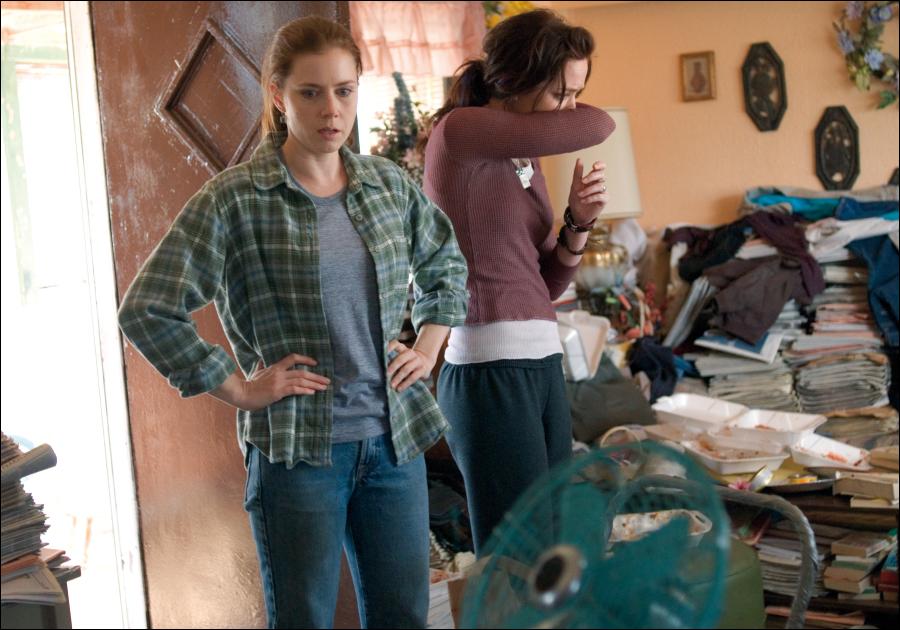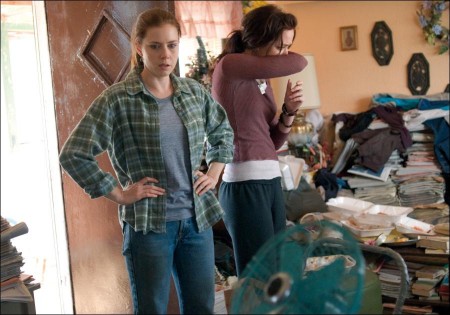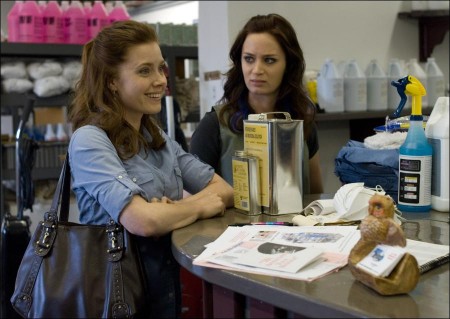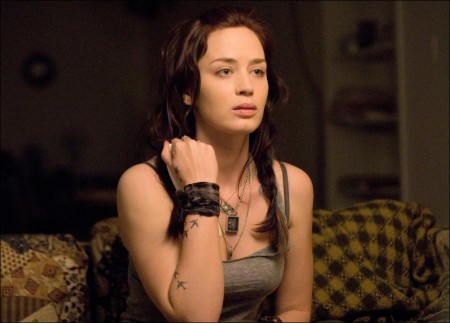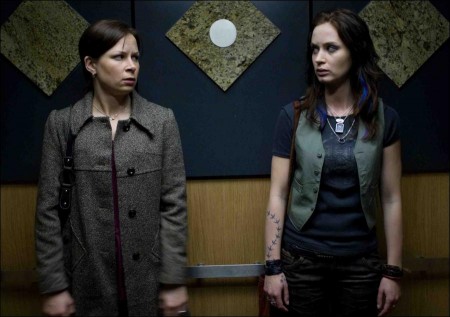About The Production
The story behind Sunshine Cleaning is almost as unlikely as the film’s tale of sisters who rebuild their lives and family bond by starting a biohazard removal company. First-time screenwriter Megan Holley was inspired by a news piece she heard on the radio about a new growth industry: the crime scene clean-up business. “I thought that it would be just a fantastic backdrop to tell a story,” she says. “I started working on the script and I wrote a couple hours every day before work. It took me a while, but I finally got it finished and I sent it off to a local screenwriting contest.”
Holley won the competition and then attracted the attention of producer and former studio executive Glenn Williamson. When Williamson agreed to serve on the board of a film festival at his alma mater, the University of Virginia, he wasn’t anticipating reading one of the most original screenplays to have crossed his desk in years. “They’d asked my office to help evaluate scripts,” he says. “My assistant read it first and said, `This is really good,’ so I read it and it was really good. When I went to Charlottesville for the festival, I made it a point to meet Megan.”
Williamson told her he wanted to produce her film. He thought the script was a perfect fit for Big Beach Films’ Peter Saraf and Marc Turtletaub, producers of the Oscar-winning indie hit Little Miss Sunshine. “Megan’s got a seriously off-beat sense of humor,” he says. “So do I, and certainly the Big Beach guys do, too.”
Coincidentally, Saraf had heard the same radio program and was riveted by the idea of a story about crime scene cleaners. “I immediately thought, wow, that would make a great movie, but I could never figure it out,” he says. “In my thinking, it was a thriller or some kind of crime story. Then this script lands on my desk, this wonderfully emotional story in which these young women start cleaning up after crimes as a way to make money and unexpectedly find a sense of self-esteem through the work.”
In another coincidence for Saraf, the boy in the film is named Oscar, as is his own son. “In Little Miss Sunshine the title character is named Olive, which is the name of my daughter; totally a coincidence,” he says. “So when I sent the script to Mark Turtletaub, he called back and he said, `So we’re only going to make movies with `Sunshine’ in the title and your kids’ names in them?’”
Saraf and his partners were sold on the project immediately. “Megan has an incredibly original voice and we don’t find that very often,” says Turtletaub. “It’s heartfelt and quirky at the same time.”
“We thought Sunshine Cleaning was funny,” he continues. “We thought it was touching. We thought it was heartbreaking. We thought it was sweet. We thought it was real. We just couldn’t say no to it. And that’s how we make movies.”
Describing Holley as “the real deal,” Brody adds, “She’s a real person who has stories to tell, and always wanted to tell them and then finally sat down and wrote this script. She had this amazing day job working with crack-addicted rats. She said she would take them home because she felt sorry for them when they were going through withdrawal.”
According to Saraf, the Big Beach producers think very carefully when selecting a director. “Filmmaking is not just an artistic process,” he says. “It’s hanging out with somebody for a couple years. You want to make sure you like their work, and you like them as a person.”
Glenn Williamson had worked with Christine Jeffs on her second film, Sylvia, starring Gwyneth Paltrow as the tragic poet, Sylvia Plath. “Christine was clearly talented with drama. She has a gift with the camera and with the actors, and I knew she’d create a visual style for this movie. This story’s got a real interesting mix of comedy and hum.”
About The Casting
At the center of Sunshine Cleaning are Rose and Norah Lorkowski, a pair of underachieving siblings hoping to make something of themselves in the field of biohazard removal. Finding actresses with just the right chemistry to play the roles opened up the story in ways that astonished even the writer. “They are different than I had imagined,” says Holley. “Better than what I had imagined. They bring a complexity that I didn’t dream of while I was writing in my room.”
Amy Adams, who plays Rose, was an early frontrunner for the role. “Amy is one of those actors who comes up with something different every take,” says producer Jeb Brody. “She’s incredibly exciting to watch, because it’s rare to see somebody who can move you in so many ways. She has the right mixture of ex-cheerleader and real depth. That depth hasn’t really been tapped very often, and this is her opportunity to show it.”
Adams says that exploring the Lorkowski family dynamic is what first attracted her to the film. “I thought Christine had such a great perspective on sisters,” she says. “We ended up having this whole conversation about sister relationships, which was something I enjoyed examining. I also really could identify with wanting to be more than you are, in a different place than you were born into, to sort of elevate your status in the world. That’s something I think a lot of people identify with.”
The actress and the director met up in Albuquerque a couple of weeks before shooting began to go over the script in depth. “Christine is so creative. She’s pushed me to make Rose quirkier and more sympathetic, and that’s been a lot of fun. She gave me some ideas that I wouldn’t have come up with myself, a couple clues that took it in a completely different direction and gave it more dimension than I thought possible.”
The casting process for the role of Norah Lorkowski led the filmmakers to versatile, award-winning actress Emily Blunt. “It was so exciting to imagine who could play Amy’s sister,” says Jeffs. “Emily turned out to be perfect.”
Working with actors whose previous roles she knows and admires was a bonus for Adams. “I was also really looking forward to working with an actress who is a peer,” she says about Blunt. “When I found out it was Emily, I was completely intimidated. I knew I was really going to have to step up.
“She’s become my partner in crime-or in crime cleanup, as it were,” Adams laughs. “When you’re playing sisters, it’s really important to pick up on each other’s rhythms. And it feels just so natural to be working with Emily. I can see her as one of my sisters.”
Adams and Blunt were virtually inseparable during production, says Jeffs. “They totally supported each other and were like dynamite together. They just had fantastic chemistry-it was an exciting combination.”
Peter Saraf had been watching Blunt’s career since he first saw her in My Summer of Love at the Toronto Film Festival. “It was my favorite movie at the festival, and I fell in love with both of the performances in that film,” he says. “And when I went to see The Devil Wears Prada, I was blown away by the fact that it was the same actress. Her performance in one movie was so beautiful and passionate and dramatic, and in the other movie it was laugh-out-loud funny. That’s exactly what Norah needed to be.
“It would have been easy to paint Norah as a character who’s a bit of a stoner and who just hasn’t done anything with her time because she’s lazy, but that’s an incredibly boring character,” says producer Glenn Williamson. “Emily brought a great amount of depth to the role. She’s so naturally funny without pushing it, and she can also just be incredibly sweet and real.”
About The Setting
Originally set in Baltimore, close to the writer’s own stomping grounds, Sunshine Cleaning was filmed in Albuquerque, New Mexico. “Albuquerque has a great feel, from the buildings to the landscape,” says Jeffs.
The financial incentives offered by the state were also a draw, but it was the unique look and feel of the southwestern city that cinched the deal, says Williamson. “We were considering several places. We were flying to Albuquerque to scout the location and we were maybe five minutes from touching down when Christine said `I love it. I want to make the movie here.’ We hadn’t even landed yet!”
Jeffs had seen photos of the city that embodied the atmosphere she sought for the film. “There is interesting book of American photography by Jeff Brouws called Approaching Nowhere,” Jeffs explains. “There are some amazing photos of Albuquerque in the book, and the city just has such a iconic kind of feel. It was strip malls and Old World all a combination of arid desert and franchise landscape.”
Albuquerque, they decided, was also the just right size town for the story. “We wanted a city that wasn’t too big,” says Turtletaub. “It also has two sides of the train tracks. Rose is somebody who had all these aspirations in high school and then ends up on the wrong side of the tracks. Albuquerque offered us that.”
Brody is sure they will be returning to Albuquerque to film in the future. “Everybody here knows exactly what they’re doing,” he says. “We worked with a group of people who had read the script and loved the project and were contributing to it as fully as they possibly could.
“Plus, you’ve got all different kinds of looks. You’ve got Route 66 with all those great old signs. You got the strip malls. You’ve got a poor demographic and a richer demographic. You’ve got a university. It’s just got so much going on.”
According to John Toon, Sunshine Cleaning’s director of photography and Jeffs’ longtime collaborator, New Mexico also afforded them the opportunity for some singular visuals. “It has a really unique flavor,” he says. “It looks different from anywhere that I’ve seen before. In terms of visual style, you can shoot wide shots, you can shoot landscapes and the light is fantastic. Everything is in close proximity, so you can travel around the city really easily.
“The production team ought to be congratulated on this film because they’re fairly free thinkers,” he continues. “They have an expansive view of how to make a movie, and they allowed us a lot of visual freedom in the making of this film. I think it will have a unique look.”
The film marks the fourth time director Jeffs worked with Toon, and she was thrilled to enlist the services of her trusted DP once again. “John does fantastic stuff,” she says. “He allowed the intimacy with the actors that I like the camera to have. He has an amazing visual sense.”
For production designer Joe Garrity and art director Guy Barnes, Sunshine Cleaning’s subject matter presented some unusual challenges. While the crime scenes needed to be realistic, they could not become the central focus of the scenes. “What Christine wanted more then anything else was realism,” says Garrity. “But the film is about the people, not about the kind of dramatic and very visual images used in horror movies. It’s more about what’s happening to these people, and we see it as a part of heir seeing it.”
Jeffs sought to strike a careful balance within the film’s tone and imagery. “I wanted it to be graphic and intimate at the same time,” she says. “The colors and spaces of Albuquerque were important to achieving that. Joe Garrity, costumer Alix Friedberg and John Toon were also huge contributors.”
Production notes provided by Overture Films.
Sunshine Cleaning
Starring: Amy Adams, Emily Blunt, Alan Arkin, Steve Zahn, Mary Lynn Rajskub, Clifton Collins
Directed by: Christine Jeffs
Screenplay by: Megan Holley
Release Date: March 13, 2009
MPAA Rating: R for language, disturbing images, some sexuality and drug use.
Studio: Overture Films
Box Office Totals
Domestic: $12,062,558 (76.5%)
Foreign: $3,703,120 (23.5%)
Total: $15,765,678 (Worldwide)
